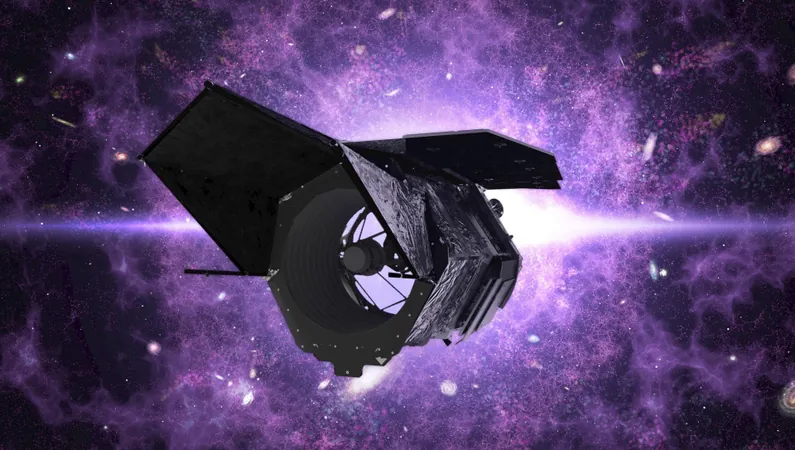
Unlocking the Mysteries of the Universe: The Roman Telescope's Quest for New Exoplanets
2025-04-11
Author: Siti
Are We Alone in the Universe?
How common are solar systems like ours? Is Earth truly special? These profound questions beckon us to dive deeper into the cosmos, where a multitude of planets orbits stars resembling our Sun. Yet, the grand tapestry of the universe remains largely a mystery.
The Roman Space Telescope: A Game Changer
Enter the Nancy Grace Roman Space Telescope, set to launch in Fall 2026, which promises to revolutionize our understanding of exoplanets—worlds beyond our solar system. With groundbreaking infrared capabilities, this high-resolution telescope is poised to uncover thousands of new planets nestled in the Milky Way. Notably, Japan is joining this exciting mission, enhancing it with advanced equipment and ground-based observations.
A Planetary Hunt Like Never Before
Since the first confirmation of an exoplanet in 1995, astronomers have identified over 5,800 of these diverse worlds. Most have been found to possess vastly different climates and orbits, often too close to their stars and tidally locked—one side perpetually facing their blazing suns, similar to our Moon’s relationship with Earth. The Roman Telescope aims to break this trend by focusing on planets that span a wider orbit, akin to giants like Jupiter and Saturn.
Beyond Earth's Limits: A Cosmic Frontier
Crafted by NASA, the Roman Space Telescope will operate far above Earth’s atmosphere, free from the distortions it creates. Positioned about 1.5 million kilometers away, at the Sun-Earth L2 Lagrange point, the telescope will capture images with unparalleled clarity.
Revealing Hidden Worlds with Gravitational Microlensing
The telescope will employ a technique known as gravitational microlensing, which occurs when a foreground star with a planet crosses in front of a brighter background star. The star’s gravity warps spacetime, providing hints of the hidden planet's existence. This rare cosmic event will be targeted in densely packed star regions like the galaxy's center to maximize discovery potential. Professor Toru Yamada from JAXA expects the discovery of approximately 2,000 new planets through this innovative approach.
A Window to the Wonders of the Universe
Boasting a primary mirror 2.4 meters in diameter, the Roman Telescope will survey areas 200 times larger than the Hubble Space Telescope could manage. Alongside its exoplanet hunt, it will delve into the enigmatic world of dark energy, the invisible force driving the universe’s expansion.
Japan's Contribution to Cosmic Research
JAXA is gearing up to enhance the mission through its PRIME telescope, located in South Africa, designed to study the Milky Way's heart. This telescope possesses one of the largest near-infrared fields of view worldwide, primed to identify numerous gravitational microlensing events, complementing the Roman's observations.
Charting New Worlds and Uncovering Life?
With observations from both terrestrial and space telescopes, scientists aim to precisely calculate the distances and masses of these planets, revealing a diverse universe of alien worlds. Takahiro Sumi, a professor at Osaka University, notes that lightweight planets far from their stars remain elusive in observations; yet, theories suggest they could be abundant. This mission aims to bridge that gap.
Peering into Distant Atmospheres for Signs of Life
Using a coronagraph—an instrument capable of blocking the blinding glare of stars—scientists aspire to glimpse faint exoplanets and analyze their atmospheric compositions. Detection of life-indicating molecules, such as oxygen and ozone, could become possible. This groundbreaking endeavor is more than a search; it’s about laying the groundwork for future telescope missions targeted at exploring these extraterrestrial worlds in greater depth.





 Brasil (PT)
Brasil (PT)
 Canada (EN)
Canada (EN)
 Chile (ES)
Chile (ES)
 Česko (CS)
Česko (CS)
 대한민국 (KO)
대한민국 (KO)
 España (ES)
España (ES)
 France (FR)
France (FR)
 Hong Kong (EN)
Hong Kong (EN)
 Italia (IT)
Italia (IT)
 日本 (JA)
日本 (JA)
 Magyarország (HU)
Magyarország (HU)
 Norge (NO)
Norge (NO)
 Polska (PL)
Polska (PL)
 Schweiz (DE)
Schweiz (DE)
 Singapore (EN)
Singapore (EN)
 Sverige (SV)
Sverige (SV)
 Suomi (FI)
Suomi (FI)
 Türkiye (TR)
Türkiye (TR)
 الإمارات العربية المتحدة (AR)
الإمارات العربية المتحدة (AR)